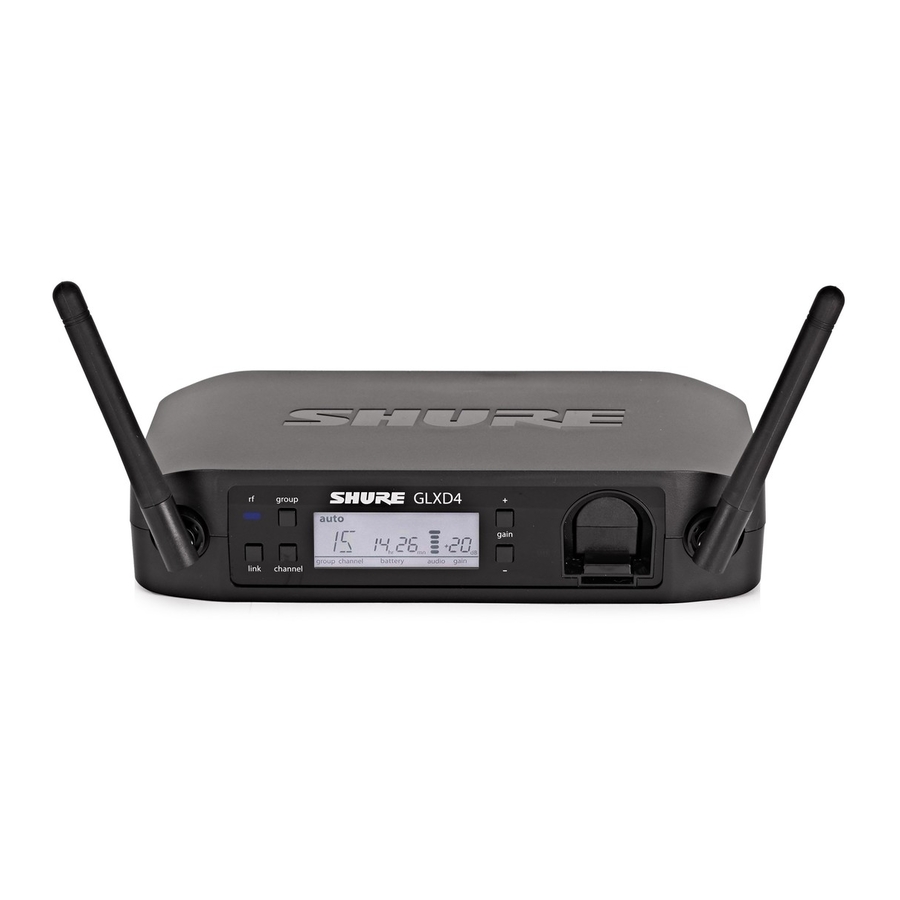Table of Contents

Summary of Contents for Shure GLXD4
- Page 1 GLX-D Wireless System GLXD4 Receiver ® User Guide Le Guide de l’Utilisateur Bedienungsanleitung Manuale d’uso Guia del Usuario Guida dell’Utente Gebruikershandleiding Руководство пользователя © 2016 Shure Incorporated 27A32537 (Rev. 1) Printed in China...
-
Page 2: Important Safety Instructions
• EMC conformance is based on the use of supplied and recommended cable types. The use of other cable types may degrade EMC performance. • Use this battery charger only with the Shure charging modules and battery packs for which it is designed. Use with other than the specified modules and bat- tery packs may increase the risk of fire or explosion. -
Page 3: System Overview
System Overview The new groundbreaking GLX-D Wireless Systems from Shure combine the leading edge of Automatic Frequency Management technology with best-in-class intelligent lithi- um-ion battery rechargeability, world-renowned microphones and unparalleled design and construction. Available in a wide offering of bodypack and handheld configurations - including vocal, headset and presenter systems as well as traditional guitar options. -
Page 4: Glxd4 Receiver Controls And Connectors
GLXD4 Receiver Controls and Connectors GLXD4 group gain link channel o / on power mic out instr out 13 14 Rear Panel Front Panel ① Antenna ⑧ Battery Charging Indicator Two antennas per receiver. Antennas pick up the signal from the transmitter. -
Page 5: Transmitter Status Led
- Press and hold within 5 seconds of power-on to manually link with receiver - Press momentarily to activate Remote ID function ⑦ Battery Compartment Holds 1 Shure rechargeable battery. ⑧ Microphone Cartridge GLXD-2 transmitter models are available with the following cartridge types: SM58, Beta 58, SM86, Beta 87A. -
Page 6: Batteries And Charging
Batteries and Charging GLX-D transmitters are powered by Shure SB902 lithium-ion rechargeable batteries. Advanced battery chemistry maximizes runtimes with zero memory effects, eliminating the need to discharge batteries prior to charging. When not in use, recommended battery storage temperature is 10°C (50°F) to 25°C (77°F). -
Page 7: Multiple Receiver Systems
Multiple Receiver Systems For ease of set up, frequencies are divided into groups to best match the channel requirements for your system. Select the group by determining the total number of receivers in your system (channel count). All receivers in the system must be set to the same group. Group Channel Count (Number of Number of Backup... -
Page 8: Overcoming The Challenges Of 2.4Ghz
2.4 GHz Spectrum Overview GLX-D operates within the 2.4GHz ISM band which is utilized by Wi-Fi, Bluetooth, and other wireless devices. The benefit of 2.4GHz is that it’s a global band that can be used anywhere in the world, license free. Overcoming the Challenges Coexisting with Wi-Fi Challenging Wireless... -
Page 9: Connect To The Computer
Firmware is embedded software in each component that controls functionality. Periodically, new versions of firmware are developed to incorporate additional features and en- hancements. To take advantage of design improvements, new versions of the firmware can be downloaded and installed using the Shure Update Utility tool. -
Page 10: Operation
Momentarily press the link button on the transmitter or receiver. The LCD of the linked receiver will blink and display ID and the sta- GLXD2 tus LED on the linked transmitter will flash red/green. GLXD4 group To exit Remote ID mode, momentarily press the link but- gain... -
Page 11: Troubleshooting
Transmitter and receiver LEDs Update both components to firmware version 2.0 or greater. flash to indicate that linking Download the Shure Update Utility application and follow the started, but the link fails instructions. Sound level variations when switching to different Adjust transmitter gain as necessary (see Gain Adjustment). -
Page 12: Specifications
Specifications Tuning Bandwidth Total Harmonic Distortion 2400– 2483. 5 MHz 0. 2% , typical Working Range RF Output Power 10 mW E.I.R.P. max Indoors Up to 30 m (100 ft ) typical , Up to 60 m (200 ft ) maximum Operating Temperature Range Outdoors Up to 20 m (65 ft ) typical , Up to 50 m (165 ft ) maximum... -
Page 13: Output Connections
XLR Output 1=ground, 2=hot, 3=cold The CE Declaration of Conformity can be obtained from Shure Incorporated or any of its European representatives. For contact information please visit www.shure.com 6.35 mm (1/4") connector Tip=audio, Ring=no audio, Sleeve=ground The CE Declaration of Conformity can be obtained from: www.shure.com/europe/...

















Need help?
Do you have a question about the GLXD4 and is the answer not in the manual?
Questions and answers